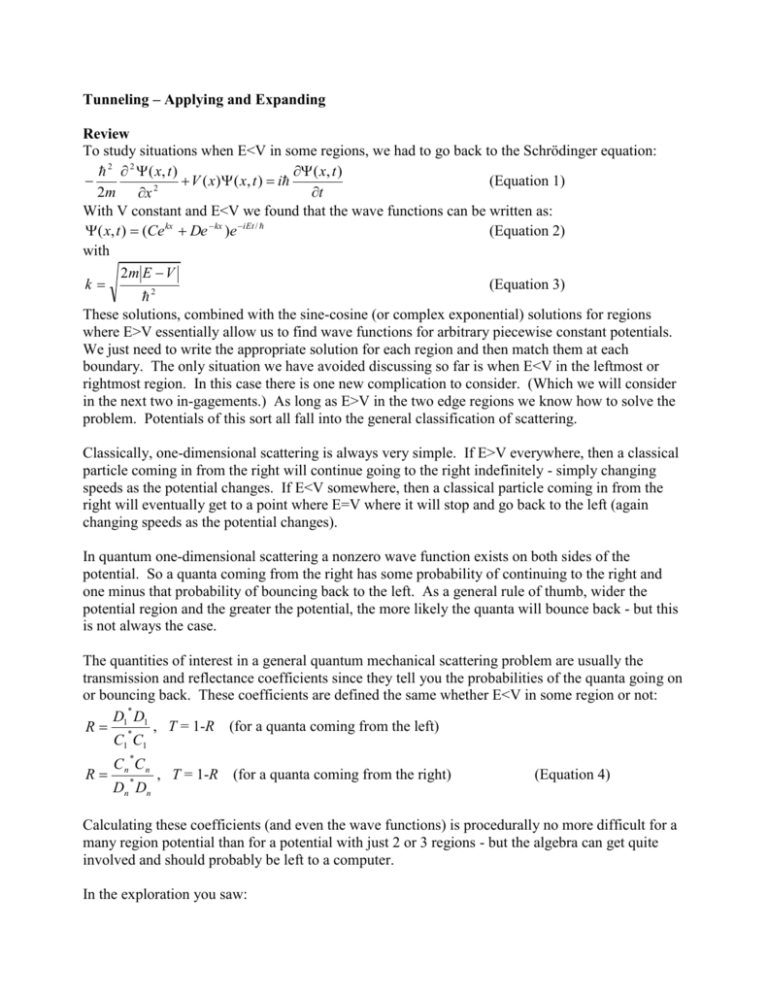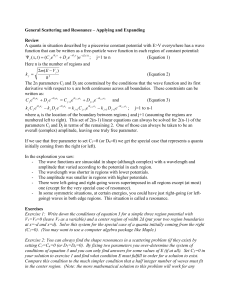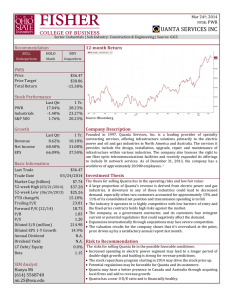Applying and Expanding
advertisement

Tunneling – Applying and Expanding Review To study situations when E<V in some regions, we had to go back to the Schrödinger equation: ( x, t ) 2 2 ( x, t ) V ( x ) ( x , t ) i (Equation 1) 2 2m x t With V constant and E<V we found that the wave functions can be written as: (Equation 2) ( x, t ) (Ce kx De kx )e iEt / with 2m E V k (Equation 3) 2 These solutions, combined with the sine-cosine (or complex exponential) solutions for regions where E>V essentially allow us to find wave functions for arbitrary piecewise constant potentials. We just need to write the appropriate solution for each region and then match them at each boundary. The only situation we have avoided discussing so far is when E<V in the leftmost or rightmost region. In this case there is one new complication to consider. (Which we will consider in the next two in-gagements.) As long as E>V in the two edge regions we know how to solve the problem. Potentials of this sort all fall into the general classification of scattering. Classically, one-dimensional scattering is always very simple. If E>V everywhere, then a classical particle coming in from the right will continue going to the right indefinitely - simply changing speeds as the potential changes. If E<V somewhere, then a classical particle coming in from the right will eventually get to a point where E=V where it will stop and go back to the left (again changing speeds as the potential changes). In quantum one-dimensional scattering a nonzero wave function exists on both sides of the potential. So a quanta coming from the right has some probability of continuing to the right and one minus that probability of bouncing back to the left. As a general rule of thumb, wider the potential region and the greater the potential, the more likely the quanta will bounce back - but this is not always the case. The quantities of interest in a general quantum mechanical scattering problem are usually the transmission and reflectance coefficients since they tell you the probabilities of the quanta going on or bouncing back. These coefficients are defined the same whether E<V in some region or not: * D D R 1* 1 , T = 1-R (for a quanta coming from the left) C1 C1 * R Cn Cn * Dn Dn , T = 1-R (for a quanta coming from the right) (Equation 4) Calculating these coefficients (and even the wave functions) is procedurally no more difficult for a many region potential than for a potential with just 2 or 3 regions - but the algebra can get quite involved and should probably be left to a computer. In the exploration you saw: - The exponential shapes of these E<V wave functions and their corresponding eigenfunctions and probability density functions. The time behavior of these functions. The two scattering traveling wave solutions with almost standing waves in the incidence region and very small traveling waves on the other side of the center region. Tunneling regions where E<V. The energy dependence of tunneling (wider regions and higher potentials generally mean less tunneling). A new kind of resonance that is somewhat like a bound state which occurs when there is a local minimum in the potential. That the wavelengths of these resonances were almost equal to half integer multiples of the width of the region containing the local minimum. (But were actually a bit longer – especially at higher energies.) Exercises Exercise 1: Write down the wave functions and boundary conditions for the situation represented in Figure 1. Solve the resulting system of equations for the special case of a quanta initially coming from the right (C1=0) and thus find the wave function for this situation. Region 1 Region 2 Region 3 V = V2 Energy Potential Energy V = V3 Total Energy x=b V = V1 x=a x Figure 1: A simple energy diagram with E<V in the center region Exercise 2: Find the transmittance and reflectance coefficients for the wave function of exercise 1. Exercise 3: For electrons with V1=0eV, V2=2eV, V3=0eV, a=-1nm, and b=1nm plot R and T (from exercise 2) vs. E for energies between 0eV and 2eV. Note that this graph extends a similar one that you made in a previous in-gagement for E>2eV. Exercise 4: Plot the probability density for the wave function of exercise 3 for E=1.98eV and E=1.0eV. Compare this to results from WFE. Exercise 4: Using your results from exercise 2, show that increasing the width or the potential energy of region 2 will increase R and decrease T. (E.g. there is less tunneling). Questions Question 1: Since the probability density in a region where E<V is non-zero, there must be some probability of finding a quanta there. What do you expect the kinetic energy of such a quanta to be? Can you think of any reason why this isn’t a big problem? Question 2: Compare the quantum probability density function with the classical probability density function for a three region potential with E<V in the center region. How are they similar? How are they different? Under what conditions do they become more or less similar? Projects Project 1: Analytically study the resonances for the 5 region potential that you studied in the exploration. Calculate the wave functions and probability densities. Calculate R and T as a function of E. Find a way to calculate the resonance energies…









